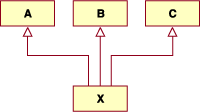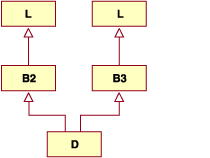
You can derive a class from any number of base classes. Deriving a class from more than one direct base class is called multiple inheritance.
In the following example, classes A, B, and C are direct base classes for the derived class X:
class A { /* ... */ };
class B { /* ... */ };
class C { /* ... */ };
class X : public A, private B, public C { /* ... */ };The following inheritance graph describes the inheritance relationships of the above example. An arrow points to the direct base class of the class at the tail of the arrow:

The order of derivation is relevant only to determine the order of default initialization by constructors and cleanup by destructors.
A direct base class cannot appear in the base list of a derived class more than once:
class B1 { /* ... */ }; // direct base class
class D : public B1, private B1 { /* ... */ }; // errorHowever, a derived class can inherit an indirect base class more than once, as shown in the following example:

class L { /* ... */ }; // indirect base class
class B2 : public L { /* ... */ };
class B3 : public L { /* ... */ };
class D : public B2, public B3 { /* ... */ }; // validIn the above example, class D inherits the indirect base class L once through class B2 and once through class B3. However, this may lead to ambiguities because two subobjects of class L exist, and both are accessible through class D. You can avoid this ambiguity by referring to class L using a qualified class name. For example:
B2::Lor
B3::L.You can also avoid this ambiguity by using the base specifier virtual to declare a base class, as described in Derivation (C++ only).